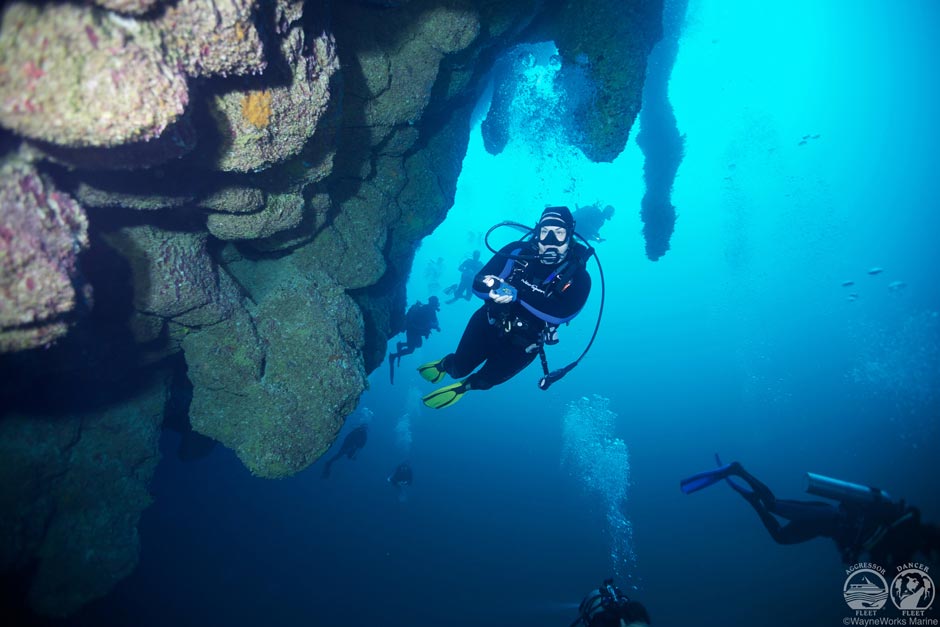 If you’re new to diving or even a seasoned pro, there has probably been a time when you were the first of your dive buddies to run out of air. At the surface, you could only scratch your head and wonder how the others still had so much air left in their tanks. If this has been you one too many times, the good news is that there are techniques to decrease your air intake safely. With these 9 tips, you surely won’t be the first one to give a thumbs up signal on your next dive, and you’ll have the tips you need in order to maximize your bottom time, safely.
If you’re new to diving or even a seasoned pro, there has probably been a time when you were the first of your dive buddies to run out of air. At the surface, you could only scratch your head and wonder how the others still had so much air left in their tanks. If this has been you one too many times, the good news is that there are techniques to decrease your air intake safely. With these 9 tips, you surely won’t be the first one to give a thumbs up signal on your next dive, and you’ll have the tips you need in order to maximize your bottom time, safely.
Master Neutral Buoyancy
By knowing how much weight you need to dive with and how to streamline your equipment, you’ll allow yourself to float effortlessly through the water. Struggling to remain buoyant uses a lot of effort and therefore wastes your air. Also, constantly putting air into your BCD only to take it out again will quickly diminish the supply in your tank.
Service Your Equipment
Make sure to check your equipment often. This will prevent any unwanted air leaks. You want to be particularly careful when checking the o-rings in your first stage and tank valve. These tend to come loose, causing loss of air before and during a dive.
Choose the Right Gear (Keep Warm)
Your body uses much more energy when cold. This problem is exacerbated in the water where we lose our body heat about 20 times faster than we do above the water. The more energy you use, the more air you waste. So, make sure you are wearing proper exposure protection. Remember that water temperature at depth can be significantly colder than temperatures at the surface.
Streamline
Don’t let your gear drag you down. Experiment with different kit set-ups to see which configuration keeps your body the most horizontal in the water. That way, you’ll become more streamlined and exert less energy in keeping yourself properly positioned.

Relax
The most successful divers are the ones who can relax completely under the surface. Nervous divers use their air rapidly and an underwater panic attack can make a tank disappear within minutes. Turn off your brain and enjoy to get the most from your diving experience.
Keep Hydrated and Well-Rested
When you are dehydrated, you use more air. This is because your red blood cells aren’t performing to the best of their abilities. Also, being fatigued can lead to cramps and increased exertion under the water. To combat both of these problems, get a good night’s sleep before you dive and always drink plenty of water before and after your dip below the surface.
Deliberate Movements
Under the water, the goal is to move as little as possible. Make slow and deliberate movements in order to streamline your body, maintain your buoyancy and keep your breathing rate under control. You’ll also want to restrict your movements to your fins only. Moving your arms creates drag and increases your body’s workload.
Use a Snorkel on the Surface
Most of us are guilty of popping our regulators in our mouths as soon as we hit the water. Many divers don’t even carry snorkels. Next time you are waiting for other divers or swimming to a dive site, use a snorkel to breath on the surface. This way you won’t waste your air when you aren’t even under the water. Be careful, though. If the conditions are rough, it’s best to use your regulator.
Practice Makes Perfect
The more diving you do, the easier these steps will become. You will feel more relaxed in the water and you’ll know the best way to configure your gear. You will also have more practice making deliberate movements and your buoyancy will improve. It’s no secret, the best tip Êto maximize Êbottom times is to dive more often.
The next time you are out for a dive, try these techniques. With any luck, you’ll have a longer dive than ever before (assuming you’re at the same depth), and you’ll be outlasting all of your dive buddies in no time!







